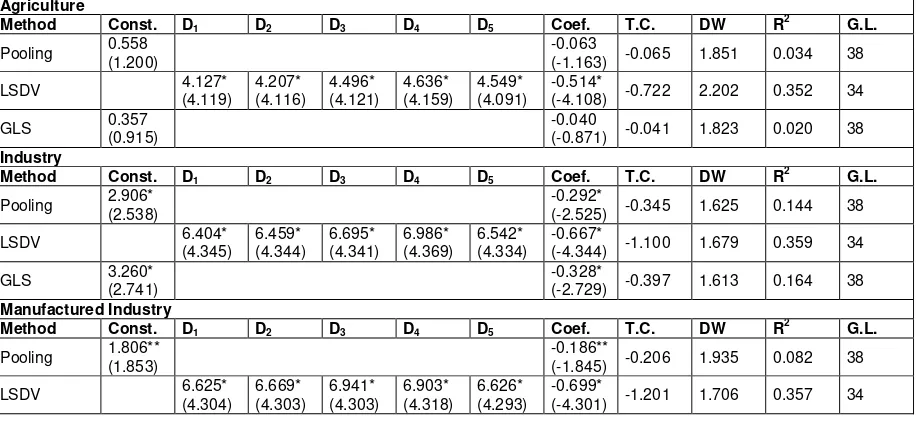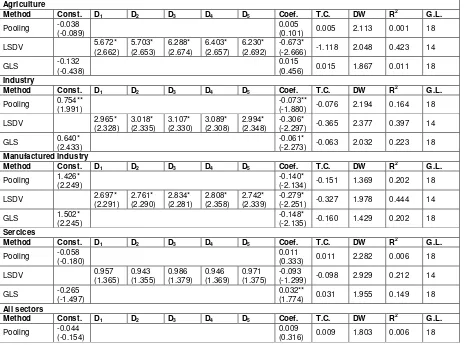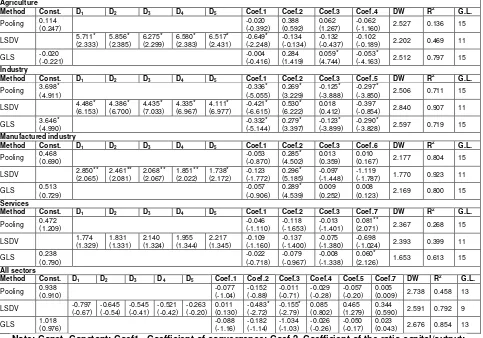Sectoral convergence in output per
worker between Portuguese regions
Martinho, Vítor João Pereira Domingues
Escola Superior Agrária, Instituto Politécnico de Viseu
2011
Online at
https://mpra.ub.uni-muenchen.de/32269/
SECTORAL CONVERGENCE IN OUTPUT PER WORKER BETWEEN
PORTUGUESE REGIONS
Vitor João Pereira Domingues Martinho
Unidade de I&D do Instituto Politécnico de Viseu
Av. Cor. José Maria Vale de Andrade
Campus Politécnico
3504 - 510 Viseu
(PORTUGAL)
e-mail:
vdmartinho@esav.ipv.pt
ABSTRACT
The aim of this paper is to present a further contribution to the analysis of absolute convergence (
and
), associated with the neoclassical theory, and conditional, associated with endogenous growth theory, of the
sectoral productivity at regional level. Presenting some empirical evidence of absolute convergence of productivity
for each of the economic sectors and industries in each of the regions of mainland Portugal (NUTS II and NUTS
III) in the period 1986 to 1994 and from 1995 to 1999. The finest spatial unit NUTS III is only considered for each
of the economic sectors in the period 1995 to 1999. They are also presented empirical evidence of conditional
convergence of productivity, but only for each of the economic sectors of the NUTS II of Portugal, from 1995 to
1999. The structural variables used in the analysis of conditional convergence is the ratio of capital/output, the
flow of goods/output and location ratio. The main conclusions should be noted that the signs of convergence are
stronger in the first period than in the second and that convergence is conditional, especially in industry and in all
sectors.
Keywords:
convergence; output; Portuguese regions
1. EMPIRICAL EVIDENCE OF ABSOLUTE CONVERGENCE, PANEL DATA
The purpose of this part of the work is to analyze the absolute convergence of output per worker (as a
"proxy" of labor productivity), with the following equation ((1)Islam, 1995, based on the (2)Solow model, 1956):
it t i it
c
b
P
P
ln
ln
,1(1)
Table 1 presents the results of absolute convergence of output per worker, obtained in the panel
estimations for each of the economic sectors and the sectors to the total level of NUTS II, from 1986 to 1994 (a
total of 45 observations, corresponding to regions 5 and 9 years).
[image:2.595.71.531.556.767.2]The convergence results obtained in the estimations carried out are statistically satisfactory to each of
the economic sectors and all sectors of the NUTS II.
Table 1:
Analysis of convergence in productivity for each economic sectors of the five NUTS II of Portugal, for the
period 1986 to 1994
Agriculture
Method Const. D1 D2 D3 D4 D5 Coef. T.C. DW R2 G.L.
Pooling 0.558 (1.200)
-0.063
(-1.163) -0.065 1.851 0.034 38
LSDV 4.127* (4.119) 4.207* (4.116) 4.496* (4.121) (4.159) 4.636* 4.549* (4.091) -0.514* (-4.108) -0.722 2.202 0.352 34
GLS 0.357 (0.915)
-0.040
(-0.871) -0.041 1.823 0.020 38
Industry
Method Const. D1 D2 D3 D4 D5 Coef. T.C. DW R
2
G.L.
Pooling 2.906* (2.538) -0.292* (-2.525) -0.345 1.625 0.144 38
LSDV 6.404* (4.345)
6.459* (4.344)
6.695* (4.341)
6.986* (4.369)
6.542* (4.334)
-0.667*
(-4.344) -1.100 1.679 0.359 34 GLS 3.260*
(2.741)
-0.328*
(-2.729) -0.397 1.613 0.164 38
Manufactured Industry
Method Const. D1 D2 D3 D4 D5 Coef. T.C. DW R
2
G.L.
Pooling 1.806** (1.853)
-0.186**
(-1.845) -0.206 1.935 0.082 38 LSDV 6.625*
(4.304)
6.669* (4.303)
6.941* (4.303)
6.903* (4.318)
6.626* (4.293)
-0.699*
GLS 1.655** (1.753) -0.171** (-1.745) -0.188 1.946 0.074 38
Services
Method Const. D1 D2 D3 D4 D5 Coef. T.C. DW R2 G.L.
Pooling 5.405* (4.499)
-0.554*
(-4.477) -0.807 1.874 0.345 38 LSDV 7.193*
(5.290)
7.169* (5.301)
7.313* (5.284)
7.153* (5.292)
7.273* (5.293)
-0.741*
(-5.275) -1.351 2.051 0.451 34
GLS 5.627* (4.626)
-0.577*
(-4.604) -0.860 1.886 0.358 38
Services (without public sector)
Method Const. D1 D2 D3 D4 D5 Coef. T.C. DW R2 G.L.
Pooling 5.865* (4.079)
-0.589*
(-4.073) -0.889 1.679 0.304 38 LSDV 6.526*
(4.197)
6.523* (4.195)
6.635* (4.191)
6.506* (4.176)
6.561* (4.192)
-0.658*
(-4.188) -1.073 1.684 0.342 34
GLS 5.027* (3.656)
-0.505*
(-3.649) -0.703 1.682 0.260 38
All sectors
Method Const. D1 D2 D3 D4 D5 Coef. T.C. DW R2 G.L.
Pooling 3.166* (3.603)
-0.328*
(-3.558) -0.397 1.785 0.250 38
LSDV 6.080* (5.361) 6.030* (5.374) 6.308* (5.347) (5.379) 6.202* 6.193* (5.359) -0.643* (-5.333) -1.030 2.181 0.460 34
GLS 3.655* (3.916)
-0.379*
(-3.874) -0.476 1.815 0.283 38
[image:3.595.69.531.70.329.2]Note: Const. Constant; Coef., Coefficient, TC, annual rate of convergence; * Coefficient statistically
significant at 5%, ** Coefficient statistically significant at 10%, GL, Degrees of freedom; LSDV, method of
fixed effects with variables dummies; D1 ... D5, five variables dummies corresponding to five different
regions, GLS, random effects method.
Table 2 shows results also for each of the economic sectors and all sectors of the NUTS II of Portugal,
but now for the period 1995 to 1999.
Table 2:
Analysis of convergence in productivity for each of the sectors and in NUTS II of Portugal, for the period
1995 to 1999
Agriculture
Method Const. D1 D2 D3 D4 D5 Coef. T.C. DW R2 G.L.
Pooling -0.038 (-0.089)
0.005
(0.101) 0.005 2.113 0.001 18 LSDV 5.672*
(2.662)
5.703* (2.653)
6.288* (2.674)
6.403* (2.657)
6.230* (2.692)
-0.673*
(-2.666) -1.118 2.048 0.423 14
GLS -0.132 (-0.438)
0.015
(0.456) 0.015 1.867 0.011 18
Industry
Method Const. D1 D2 D3 D4 D5 Coef. T.C. DW R
2
G.L.
Pooling 0.754** (1.991)
-0.073**
(-1.880) -0.076 2.194 0.164 18
LSDV 2.965* (2.328) 3.018* (2.335) 3.107* (2.330) (2.308) 3.089* 2.994* (2.348) -0.306* (-2.297) -0.365 2.377 0.397 14
GLS 0.640* (2.433)
-0.061*
(-2.273) -0.063 2.032 0.223 18
Manufactured industry
Method Const. D1 D2 D3 D4 D5 Coef. T.C. DW R
2
G.L.
Pooling 1.426* (2.249)
-0.140*
(-2.134) -0.151 1.369 0.202 18 LSDV 2.697*
(2.291)
2.761* (2.290)
2.834* (2.281)
2.808* (2.358)
2.742* (2.339)
-0.279*
(-2.251) -0.327 1.978 0.444 14 GLS 1.502*
(2.245)
-0.148*
(-2.135) -0.160 1.429 0.202 18
Sercices
Method Const. D1 D2 D3 D4 D5 Coef. T.C. DW R
2
G.L.
Pooling -0.058 (-0.180)
0.011
(0.333) 0.011 2.282 0.006 18 LSDV 0.957
(1.365) 0.943 (1.355)
0.986 (1.379)
0.946 (1.369)
0.971 (1.375)
-0.093
(-1.299) -0.098 2.929 0.212 14 GLS -0.265
(-1.497)
0.032**
(1.774) 0.031 1.955 0.149 18
All sectors
Method Const. D1 D2 D3 D4 D5 Coef. T.C. DW R
2
G.L.
Pooling -0.044 (-0.154)
0.009
[image:3.595.68.532.428.773.2]LSDV 0.954 (1.383) 0.949 (1.380) 0.999 (1.392) (1.356) 0.948 0.980 (1.398) -0.095 (-1.316) -0.100 2.714 0.365 14
GLS 0.014 (0.045)
0.003
(0.100) 0.003 1.925 0.001 18
Looking at the coefficient of convergence, we now find evidence of absolute convergence only for
agriculture, industry and manufactured industry.
Are presented subsequently in Table 3 the results of the absolute convergence of output per worker,
obtained in the panel estimations for each of the sectors and all sectors, now at the level of NUTS III during the
period 1995 to 1999.
[image:4.595.67.529.70.111.2]The results of convergence are statistically satisfactory all sectors and sectors to the total level of NUTS
III.
Table 3
: Analysis of convergence in productivity for each of the economic sectors at the level of NUTS III of
Portugal, for the period 1995 to 1999
Agriculture
Method Const. Coef. T.C. DW R2 G.L.
Pooling 0.017 (0.086)
-0.003
(-0.146) -0.003 2.348 0.000 110 LSDV -0.938*
(-9.041) -2.781 2.279 0.529 83
GLS -0.219* (-3.633)
0.024*
(3.443) 0.024 1.315 0.097 110
Industry
Method
Const. Coef. T.C. DW R2 G.L.Pooling 0.770* (4.200)
-0.076*
(-4.017) -0.079 1.899 0.128 110 LSDV -0.511*
(-7.784) -0.715 2.555 0.608 83
GLS 0.875* (4.154)
-0.086*
(-3.994) -0.090 2.062 0.127 110
Services
Method
Const. Coef. T.C. DW R2 G.L.Pooling 0.258 (1.599)
-0.022
(-1.314) -0.022 1.955 0.016 110 LSDV -0.166*
(-5.790) -0.182 2.665 0.382 83 GLS 0.089
(0.632)
-0.004
(-0.303) -0.004 1.868 0.001 110
All sectors
Method
Const.
Coef.
T.C.
DW
R
2G.L.
“Pooling”
0.094
(0.833)
-0.005
(-0.445)
-0.005
2.234
0.002
110
LSDV
-0.156*
(-3.419)
-0.170
2.664
0.311
83
GLS
0.079
(0.750)
-0.004
(-0.337)
-0.004
2.169
0.001
110
Table 4 presents the results for the absolute convergence of output per worker, in the estimations
obtained for each of the manufactured industry of NUTS II, from 1986 to 1994.
[image:4.595.69.528.240.559.2]The convergence results obtained are statistically satisfactory for all manufacturing industries of NUTS II.
Table 4
: Analysis of convergence in productivity for each of the manufacturing industries at the five NUTS II of
Portugal, for the period 1986 to 1994
Metals industry
Method Const. D1 D2 D3 D4 D5 Coef. T.C. DW R2 G.L.
Pooling 0.190 (0.190)
-0.024
(-0.241) -0.024 1.646 0.002 30 LSDV 2.171**
(1.769)
2.143** (1.753)
2.161** (1.733)
2.752** (1.988) ---
-0.239**
(-1.869) -0.273 1.759 0.198 27 GLS 0.407
(0.394)
-0.046
(-0.445) -0.047 1.650 0.007 30
MInerals industry
Method Const. D1 D2 D3 D4 D5 Coef. T.C. DW R2 G.L.
Pooling 0.738 (0.903)
-0.085
(-0.989) -0.089 1.935 0.025 38
LSDV 1.884* (2.051)
1.970* (2.112)
2.004* (2.104)
1.926* (2.042)
1.731** (1.930)
-0.208*
[image:4.595.67.530.635.769.2]GLS 0.967 (1.162) -0.109 (-1.246) -0.115 1.966 0.039 38
Chemical industry
Method Const. D1 D2 D3 D4 D5 Coef. T.C. DW R2 G.L.
Pooling 2.312** (1.992)
-0.225**
(-1.984) -0.255 2.017 0.104 34 LSDV 6.104*
(3.750) 6.348* (3.778) 6.381* (3.774) 6.664* (3.778) 6.254* (3.777) -0.621*
(-3.769) -0.970 1.959 0.325 30
GLS 2.038** (1.836)
-0.198**
(-1.826) -0.221 2.034 0.089 34
Electric goods industry
Method Const. D1 D2 D3 D4 D5 Coef. T.C. DW R2 G.L.
Pooling 0.781 (0.789)
-0.083
(-0.784) -0.087 1.403 0.016 38 LSDV 3.634*
(2.363) 3.552* (2.360) 3.673* (2.362) 3.636* (2.376) 3.429* (2.324) -0.381*
(-2.355) -0.480 1.259 0.167 34
GLS 0.242 (0.285)
-0.025
(-0.279) -0.025 1.438 0.002 38
Transport equipments industry
Method Const. D1 D2 D3 D4 D5 Coef. T.C. DW R2 G.L.
Pooling 4.460* (3.110)
-0.464*
(-3.136) -0.624 2.258 0.206 38
LSDV 8.061* (4.948) 8.526* (5.007) 8.614* (4.986) (4.998) 8.696* 8.077* (4.961) -0.871* (-5.014) -2.048 2.049 0.429 34
GLS 5.735* (3.780)
-0.596*
(-3.807) -0.906 2.159 0.276 38
Food industry
Method Const. D1 D2 D3 D4 D5 Coef. T.C. DW R
2
G.L.
Pooling 0.314 (0.515)
-0.027
(-0.443) -0.027 1.858 0.005 38
LSDV 2.841* (2.555) 2.777* (2.525) 2.899* (2.508) 2.617* (2.471) 2.593* (2.470) -0.274*
(-2.469) -0.320 1.786 0.198 34 GLS 0.090
(0.166)
-0.005
(-0.085) -0.005 1.851 0.001 38
Textile industry
Method Const. D1 D2 D3 D4 D5 Coef. T.C. DW R
2
G.L.
Pooling 4.276* (4.639)
-0.462*
(-4.645) -0.620 1.836 0.388 34 LSDV 5.556*
(4.288) 5.487* (4.276) 5.506* (4.272) 5.561* (4.253) 5.350* (4.431) -0.595*
(-4.298) -0.904 1.816 0.431 30 GLS 3.212*
(6.336)
-0.347*
(-6.344) -0.426 1.848 0.542 34
Paper industry
Method Const. D1 D2 D3 D4 D5 Coef. T.C. DW R
2
G.L.
Pooling 2.625* (2.332)
-0.271*
(-2.366) -0.316 1.534 0.128 38 LSDV 3.703*
(2.803) 3.847* (2.840) 3.837* (2.813) 3.684* (2.812) 3.521* (2.782) -0.382*
(-2.852) -0.481 1.516 0.196 34 GLS 1.939**
(1.888)
-0.201**
(-1.924) -0.224 1.556 0.089 38
Several industry
Method Const. D1 D2 D3 D4 D5 Coef. T.C. DW R
2
G.L.
Pooling 5.518* (4.004)
-0.605*
(-4.004) -0.929 2.121 0.297 38 LSDV 7.802*
(5.036) 7.719* (5.022) 7.876* (5.033) 7.548* (5.023) 7.660* (5.018) -0.847*
(-5.032) -1.877 2.024 0.428 34
GLS 6.053* (4.308) -0.664* (-4.309) -1.091 2.081 0.328 38
[image:5.595.72.533.709.767.2]Table 5 shows results also for each of the manufacturing industries of the NUTS II of Portugal, but now
for the period 1995 to 1999.
Table 5
: Analysis of convergence in productivity for each of the manufacturing industries at the five NUTS II of
Portugal, for the period 1995 to 1999
Metals industry
Method Const. D1 D2 D3 D4 D5 Coef. T.C. DW R2 G.L.
Pooling 1.108* (3.591)
-0.111*
(-3.353) -0.118 2.457 0.384 18 LSDV 1.476
(1.143) 1.496 (1.183) 1.503 (1.129) 1.451 (1.186) 1.459 (1.233) -0.151
GLS 1.084* (7.366) -0.108* (-6.866) -0.114 2.176 0.724 18
Minerals industry
Method Const. D1 D2 D3 D4 D5 Coef. T.C. DW R2 G.L.
Pooling -0.455 (-1.236)
0.052
(1.409) 0.051 1.601 0.099 18 LSDV 2.158*
(2.222)
2.280* (2.265)
2.287* (2.227)
2.194* (2.248)
2.417* (2.306)
-0.221*
(-2.192) -0.250 1.359 0.567 14
GLS -0.356 (-0.854)
0.042
(1.007) 0.041 1.628 0.053 18
Chemical industry
Method Const. D1 D2 D3 D4 D5 Coef. T.C. DW R2 G.L.
Pooling 1.236 (1.026)
-0.115
(-0.966) -0.122 1.049 0.049 18 LSDV 5.320*
(4.493)
5.281* (4.452)
5.447* (4.449)
5.858* (4.711)
5.072* (4.501)
-0.525*
(-4.470) -0.744 2.432 0.702 14
GLS 3.136* (2.532)
-0.302*
(-2.477) -0.360 1.174 0.254 18
Electric goods industry
Method Const. D1 D2 D3 D4 D5 Coef. T.C. DW R2 G.L.
Pooling 1.936 (1.289)
-0.196
(-1.271) -0.218 1.945 0.082 18
LSDV 4.729 (1.504) 4.775 (1.507) 4.818 (1.490) 4.590 (1.463) 4.671 (1.519) -0.482 (-1.488) -0.658 2.038 0.342 14
GLS 2.075 (1.299)
-0.211
(-1.283) -0.237 1.976 0.084 18
Transport equipments industry
Method Const. D1 D2 D3 D4 D5 Coef. T.C. DW R
2
G.L.
Pooling 2.429* (2.264)
-0.237*
(-2.179) -0.270 1.837 0.209 18
LSDV 8.626* (10.922) 8.647* (10.973) 9.051* (10.924) 8.537* (10.917) 8.356* (10.866)
-0.867* (-10.811)
-2.017 2.000 0.896 14
GLS 3.507* (3.025)
-0.346*
(-2.947) -0.425 1.649 0.326 18
Food industry
Method Const. D1 D2 D3 D4 D5 Coef. T.C. DW R2 G.L.
Pooling 0.873 (1.619)
-0.082
(-1.453) -0.086 2.921 0.105 18
LSDV -0.516 (-0.300)
-0.521 (-0.308)
-0.532 (-0.304)
-0.425 (-0.259)
-0.435 (-0.268)
0.060
(0.341) 0.058 2.230 0.208 14 GLS 1.027*
(4.163)
-0.098*
(-3.800) -0.103 2.251 0.445 18
Textile industry
Method Const. D1 D2 D3 D4 D5 Coef. T.C. DW R
2
G.L.
Pooling 0.788** (2.048) -0.080** (-1.882) -0.083 1.902 0.165 18
LSDV 0.514 (0.261)
0.525 (0.270)
0.515 (0.262)
0.522 (0.272)
0.541 (0.301)
-0.051
(-0.239) -0.052 1.919 0.167 14
GLS 0.802* (20.052)
-0.081* (-18.461)
-0.085 1.719 0.950 18
Paper industry
Method Const. D1 D2 D3 D4 D5 Coef. T.C. DW R
2
G.L.
Pooling 0.735 (1.524)
-0.073
(-1.471) -0.076 2.341 0.107 18
LSDV 5.201 (1.479)
5.454 (1.462)
5.410 (1.467)
5.053 (1.470)
4.970 (1.486)
-0.533
(-1.465) -0.761 1.939 0.227 14 GLS 0.654*
(3.329)
-0.064*
(-3.198) -0.066 2.185 0.362 18
Several industry
Method Const. D1 D2 D3 D4 D5 Coef. T.C. DW R
2
G.L.
Pooling -0.338 (-0.463) 0.042 (0.531) 0.041 2.651 0.015 18
LSDV 3.734** (1.949)
3.883** (1.962)
3.940** (1.966)
3.817** (1.967)
3.647** (1.934)
-0.402**
(-1.930) -0.514 2.905 0.303 14 GLS -0.904*
(-3.791)
0.102*
2. EMPIRICAL EVIDENCE OF CONDITIONAL CONVERGENCE WITH PANEL DATA
This part of the work aims to analyze the conditional convergence of labor productivity sectors (using as
a "proxy" output per worker) between the different NUTS II of Portugal, from 1995 to 1999.
Given these limitations and the availability of data, it was estimated in this part of the work equation (1)
introducing some structural variables, namely, the ratio of gross fixed capital/output (such as "proxy" for the
accumulation of capital/output ), the flow ratio of goods/output (as a "proxy" for transport costs) and the location
quotient (calculated as the ratio between the number of regional employees in a given sector and the number of
national employees in this sector on the ratio between the number regional employment and the number of
national employees) ((3) Sala-i-Martin, 1996).
[image:7.595.59.542.238.576.2]Considering the results obtained and presented in Table 6 (for conditional convergence), compared with
those presented in Table 2 (absolute convergence), it appears that only in industry and all sectors is that the
coefficient of convergence improve.
Table 6
: Analysis of conditional convergence in productivity for each of the sectors at NUTS II of Portugal, for the
period 1995 to 1999
Agriculture
Method Const. D1 D2 D3 D4 D5 Coef.1 Coef.2 Coef.3 Coef.4 DW R2 G.L.
Pooling 0.114 (0.247) -0.020 (-0.392) 0.388 (0.592) 0.062 (1.267) -0.062
(-1.160) 2.527 0.136 15
LSDV 5.711*
(2.333) 5.856* (2.385) 6.275* (2.299) 6.580* (2.383) 6.517* (2.431) -0.649* (-2.248) -0.134 (-0.134) -0.132 (-0.437) -0.102
(-0.189) 2.202 0.469 11
GLS -0.020 (-0.221) -0.004 (-0.416) 0.284 (1.419) 0.059* (4.744) -0.053*
(-4.163) 2.512 0.797 15 Industry
Method Const. D1 D2 D3 D4 D5 Coef.1 Coef.2 Coef.3 Coef.5 DW R2 G.L.
Pooling 3.698* (4.911) -0.336* (-5.055) 0.269* (3.229) -0.125* (-3.888) -0.297*
(-3.850) 2.506 0.711 15
LSDV 4.486*
(6.153) 4.386* (6.700) 4.435* (7.033) 4.335* (6.967) 4.111* (6.977) -0.421* (-6.615) 0.530* (6.222) 0.018 (0.412) -0.397
(-0.854) 2.840 0.907 11
GLS 3.646* (4.990) -0.332* (-5.144) 0.279* (3.397) -0.123* (-3.899) -0.290* (-3.828) 2.597 0.719 15
Manufactured industry
Method Const. D1 D2 D3 D4 D5 Coef.1 Coef.2 Coef.3 Coef.6 DW R2 G.L.
Pooling 0.468 (0.690) -0.053 (-0.870) 0.285* (4.502) 0.013 (0.359) 0.010
(0.167) 2.177 0.804 15
LSDV 2.850**
(2.065) 2.461** (2.081) 2.068** (2.067) 1.851** (2.022) 1.738* (2.172) -0.123 (-1.772) 0.296* (5.185) -0.097 (-1.448) -1.119
(-1.787) 1.770 0.923 11
GLS 0.513 (0.729) -0.057 (-0.906) 0.289* (4.539) 0.009 (0.252) 0.008
(0.123) 2.169 0.800 15 Services
Method Const. D1 D2 D3 D4 D5 Coef.1 Coef.2 Coef.3 Coef.7 DW R2 G.L.
Pooling 0.472 (1.209) -0.046 (-1.110) -0.118 (-1.653) -0.013 (-1.401) 0.081**
(2.071) 2.367 0.268 15
LSDV 1.774
(1.329) 1.831 (1.331) 2.140 (1.324) 1.955 (1.344) 2.217 (1.345) -0.109 (-1.160) -0.137 (-1.400) -0.075 (-1.380) -0.698
(-1.024) 2.393 0.399 11
GLS 0.238 (0.790) -0.022 (-0.718) -0.079 (-0.967) -0.008 (-1.338) 0.060*
(2.126) 1.653 0.613 15 All sectors
Method Const. D1 D2 D3 D4 D5 Coef.1 Coef.2 Coef.3 Coef.4 Coef.5 Coef.7 DW R2 G.L.
Pooling 0.938 (0.910) -0.077 (-1.04) -0.152 (-0.88) -0.011 (-0.71) -0.029 (-0.28) -0.057 (-0.20) 0.005
(0.009) 2.738 0.458 13
LSDV -0.797
(-0.67) -0.645 (-0.54) -0.545 (-0.41) -0.521 (-0.42) -0.263 (-0.20) 0.011 (0.130) -0.483* (-2.72) -0.155* (-2.79) 0.085 (0.802) 0.465 (1.279) 0.344
(0.590) 2.591 0.792 9
GLS 1.018 (0.976) -0.088 (-1.16) -0.182 (-1.14) -1.034 (-1.03) -0.026 (-0.26) -0.050 (-0.17) 0.023 (0.043) 2.676 0.854 13




